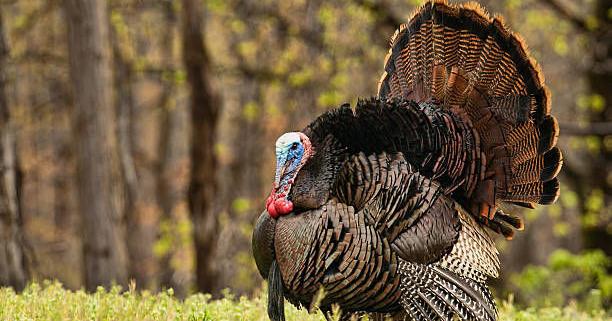While it is 10 days later than the traditional opener, hunters finally get to head to the field to chase a big ole Tom turkey beginning Sunday.
The season runs April 16- May 16, statewide, and is open to shotgun and archery equipment. Keeping with last years reduced bag limit, hunters can only harvest 1 tom turkey. For regulations, specific firearms and archery requirements, consult the current “Oklahoma Hunting Guide.”
These changes are due to a rapid decline in turkey populations the past three seasons. More than 67 percent in the Southwest Region.
Biologists decided a couple of years ago that something needed to be done. The first goal is to immediately address the decline. The next goal is to conduct scientific research to learn what is causing the decline and what can be done long-term to best manage wild turkey populations.
The quickest way to effect change is to alter the hunting regulations. So, proposals were brought forth to alter season dates and bag limits. An opinion survey of turkey hunters generated more than 5,200 comments — an all-time high for hunter input on a proposed change in regulations. Interestingly, hunters supported reducing the spring bag limit to two toms as proposed by the Wildlife Department, but nearly 30 percent offered an unsolicited suggestion to reduce the bag limit to one tom.
The Wildlife Department has prioritized turkey research as a critical need, resulting in a research partnership with Oklahoma State University to address turkey population concerns. The OSU research team is in the second year of a 4 ½-year investigation to address wild turkey population dynamics and brood survival. In order to get answers for why our turkey population has declined, this research will take a very intentional and stepwise look at several important life stages of the species, with the hope of finding variables impacting the population at each step in the life of a wild turkey.
Oklahoma is home to two main subspecies of wild turkeys — the Rio Grande and the Eastern — but occasionally the Merriam subspecies can be found in the far western edge of the Panhandle. According to biologists with the Oklahoma Department of Wildlife Conservation, hunters should be successful during turkey season in areas across the state.
Time will only tell how these season changes will affect turkey populations.
One thing that will help with the later season is that birds have moved away from their winter roosts in most areas. Since then, smaller groups of hens and jakes have begun to separate themselves as they spread across their range. Mature gobblers have began to strut and separate themselves.
According to Ron Smith, wildlife biologist with the Oklahoma Department of Wildlife Conservation, lower turkey numbers and birds moving into new areas make scouting more important than ever. Be willing to spend the day following turkey activity. Gobblers may be more easily called away from hens later in the day. Landowners have also reported seeing turkeys moving into new areas and an absence of birds in historic areas.
If hunters don’t have access to private land, Smith recommends Black Kettle, Packsaddle, Waurika, Fort Cobb, and Sandy Sanders WMAs. Be sure to consult the Hunting Guide for WMA regulations.
The wild turkey in Oklahoma is part of an enormous conservation success story. In the 1920s, wild turkeys were very rare in Oklahoma and all across the nation. Overharvest from market hunting, timbering for construction of homesteads, land use changes and market logging in Oklahoma’s early years took a toll on the wild turkey, but a stocking program by the Wildlife Department in the late 1940s helped re-establish the wild turkey to its former range across the state.
To hunt turkeys, sportsmen need an appropriate state hunting license and fishing and hunting legacy permit as well as a turkey license, unless exempt. Upon harvesting a turkey, all annual license holders and lifetime license holders, must attach their name and hunting license number to their turkey as soon as it is harvested. Only toms, or bearded turkeys, may be taken during the spring season.
Hunters may use shotguns with pellets, or archery equipment for the spring season. Rifles, pistols or muzzleloaders that shoot single bullets are not allowed.
Youth who have completed a hunter education course can purchase a turkey license and hunt unaccompanied (except for during the youth turkey season, when they must be accompanied by an adult age 18 or older). Resident youth under 16 and non-residents under 14 who have not completed a hunter education course can purchase a turkey license, but it will have an apprentice designation and they must be accompanied by a qualified licensed adult hunter.
For requirements on who must accompany apprentice hunters in the field, or for more information about the spring turkey season, consult the current “Oklahoma Hunting Guide” or log on to the Wildlife Department’s Web site at wildlifedepartment.com.
Turkey tips — Here are some more tips offered by ODWC Biologists to make your season more successful:
· Scouting allows hunters to know birds general movements. Where are they feeding, strutting and roosting. All important to know when setting up for that early morning or evening hunt.
· Don’t get too close while birds are on the roost. Give birds enough room to fly down and get oriented.
· Calling too much. Lots of hunters like to hear those gobblers gobbling back, but excessive calling is not a normal interaction between turkeys in the wild and can often cause toms to hang up.
· Don’t underestimate a turkey’s vision. Decoys help distract a turkey’s attention, but be sure to move only when they cannot see you.
· There is a famous adage: “By failing to prepare, you are preparing to fail.” While it probably didn’t originally refer to turkey hunting, it still applies. Wipe the dust off that old shotgun and pattern some loads.
· Speaking of shotshell loads – new ammunition is great, with duplex or triple size loads, but none of that matters if you don’t pattern your shotgun. Try different loads and different chokes for the best shot density.
· Hunters often forget that turkeys “live there all day.” Discounting the rest of the day is a common mistake. Turkeys are subject to sound off throughout the day.
· Pay attention to your setup when you get ready to call a bird. Be mindful of obstacles such as thickets, creeks, or fencerows. Turkeys often don’t want to cross these and will “hang up.”
· Try to be uphill of the bird, as they are often reluctant to come downhill to a call.
· Pay attention to the birds’ subtle communications and work your way into their system.
Apply Now for Controlled Hunts
The Oklahoma Department of Wildlife Conservation Controlled Hunts application period is open now through May 22. Hunters can enter drawings for a host of quality, ODWC-sanctioned hunts for species like deer, elk, antelope and turkey!
Two important changes to the program are being implemented this year, including the option to purchase additional hunt choice selections and better odds for certain elk and antelope hunt applicants:
Extra opportunities — After applicants have reached the maximum number of hunt choices allowed in a category (up to 14 hunt choices across four categories for $5 application fee), applicants will then be allowed to buy additional hunt choices at $3 per choice. There is no limit to how many extra hunt choices can be purchased, but applicants can only select a specific hunt once. Also, applicants will be able to add PointGuard insurance to each category, a safeguard against losing preference points in case the hunter cannot attend any of the hunts he wins.
Elk/Pronghorn Allocated Draws — For these once-in-a-lifetime hunt categories, an initial drawing for half of all hunt permits will be taken from the pool of only those applicants having 20 or more preference points. The remaining half of all hunt permits will be drawn from the pool of everyone who applied (excluding hunt winners from the initial drawing).
To apply, log into your Go Outdoors Oklahoma profile at Wildlifedepartment.com and select the “Controlled Hunts” tile.
SIDEBAR
SW Fishing Report
Fort Cobb — Elevation is 5 ft. below normal (stable), water temperature 57°F and stained. Crappie, Black, Crappie, White good on jigs, minnows around docks.
Altus-Lugert — Elevation is 24 ft. below normal (stable), water temperature 63°F and stained. No fishing activity.
Tom Steed — Elevation is 6 ft. below normal (falling), water temperature 55°F and murky. Crappie, White fair on jigs, minnows around brush structure, rocks, shorelines. Bass, Striped Hybrid, White Bass, Saugeye fair on crankbaits, jigs, minnows, sassy shad around points, rocks. Catfish, Blue good on cut bait, punch bait, stinkbait around flats, rocks, standing timber.
Ellsworth — Elevation is 3 ft. below normal (stable), water temperature 53°F and murky. Sand Bass good on small lures, spinnerbaits around main lake. Crappie, Gar, fair on jigs, minnows around brush structure, docks, rocks. Catfish, fair on dough bait, punch bait, shad around main lake, points.
Lawtonka — Elevation is 3 ft. below normal (stable), water temperature 54°F and clear. Sand Bass fair on small lures, spinnerbaits around main lake, points, rocks. Crappie fair on jigs, minnows around brush structure, docks, rocks.
Waurika — Elevation is 3 ft. below normal (stable), water temperature 59°F and murky. Sand Bass and Hybrids fair on crankbaits, flukes around main lake, shorelines. Catfish fair on cut bait around main lake, shorelines. Crappie fair on jigs, minnows around brush, structure, docks and riprap.
Want to reach a local audience and grow your business?
Our website is the perfect platform to connect with engaged readers in your local area.
Whether you're looking for banner ads, sponsored content, or custom promotions, we can tailor a package to meet your needs.
Contact us today to learn more about advertising opportunities!
CONTACT US NOW






